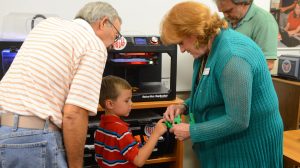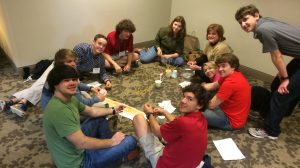
Marsha Hobbs (in green top) discusses 3-D graphics with students enrolled in Engineering 100 class at Jackson Preparatory School. Submitted photo
Marsha Hobbs had been teaching physics and engineering courses at Jackson Preparatory School for two decades when she decided it was time for a change: not where she taught or what she taught, but how she taught.
“I just thought it was time for a 21st-century approach,” said Hobbs, who holds degrees in physics and electrical engineering from the University of Virginia. “These kids have grown up with the internet and technology. That has changed the way they learn. They like a more hands-on approach.”
So that’s what Hobbs gave her students. She developed a project-based engineering course that emphasized collaboration and kinesthetic learning over traditional text and lecture methods. She set up the “FabLab,” outfitted with everything from a 3-D printer to soldering irons, and “maker spaces” to facilitate individual experimentation.
As she was organizing her new course, Hobbs also wanted to make sure that it would be a gateway to the engineering profession. Toward that goal, she worked with Marni Kendricks, assistant dean of the University of Mississippi School of Engineering, to establish a dual-enrollment program with the university. Once again, she was breaking new ground.
“This was the first dual credit at our school,” Hobbs said. “I made a ‘cold’ call to the (engineering school) and was immediately put in contact with Kendricks. I think they had done this somewhere before, but she and I basically tailored it to the needs of our schools.”
The two women teamed up for the ENGR 100 course and co-taught an engineering graphics course. Witt Lovelace, now a junior mechanical engineering major, was one of the first dual-enrollment students to benefit from Kendricks and Hobbs’ class.
“Both women are very understanding of industry needs,” Lovelace said. “With the help of programs like AutoCAD and Arduino, their students have been able to further advance their engineering ‘tool boxes.’ They both understand teamwork, communication and the organizational skills that the best engineers utilize every day.”
Lila Burton, another member of the inaugural class, agreed.
“Mrs. Hobbs was a great teacher that guided me in deciding on my major at the University of Mississippi as a chemical engineer,” she said. “Through the course she taught, I was prepared more than the others here at the university, and already ahead on how to use a variety of software that is utilized in the engineering curriculum, such as AutoCAD. Along with the syllabus and Mrs. Hobbs’ guidance, I highly recommend taking the opportunity of dual enrollment in order to advance with a major in the STEM programs.”
As a former engineer herself, connecting theoretical learning objectives with practical skills is something Hobbs believes will help promote interest in the field of engineering.
“The skills the students learn teach them to think like engineers,” she said. “They just finished the mousetrap catapult. I was fascinated to see them engage with the design process. I know that will improve throughout the year.”
Giving her students a valuable head start might be reward enough for a dedicated teacher, but Hobbs’ work has also been recognized nationally. In 2016, she received the Presidential Award for Excellence in Mathematics and Science Teaching on behalf of the White House Office of Science and Technology Policy, administered by the National Science Foundation.
